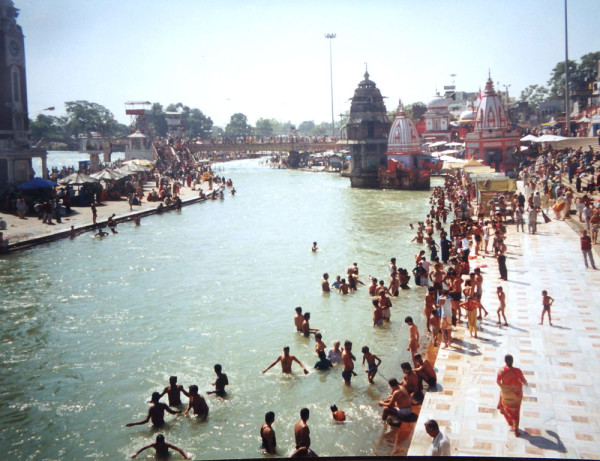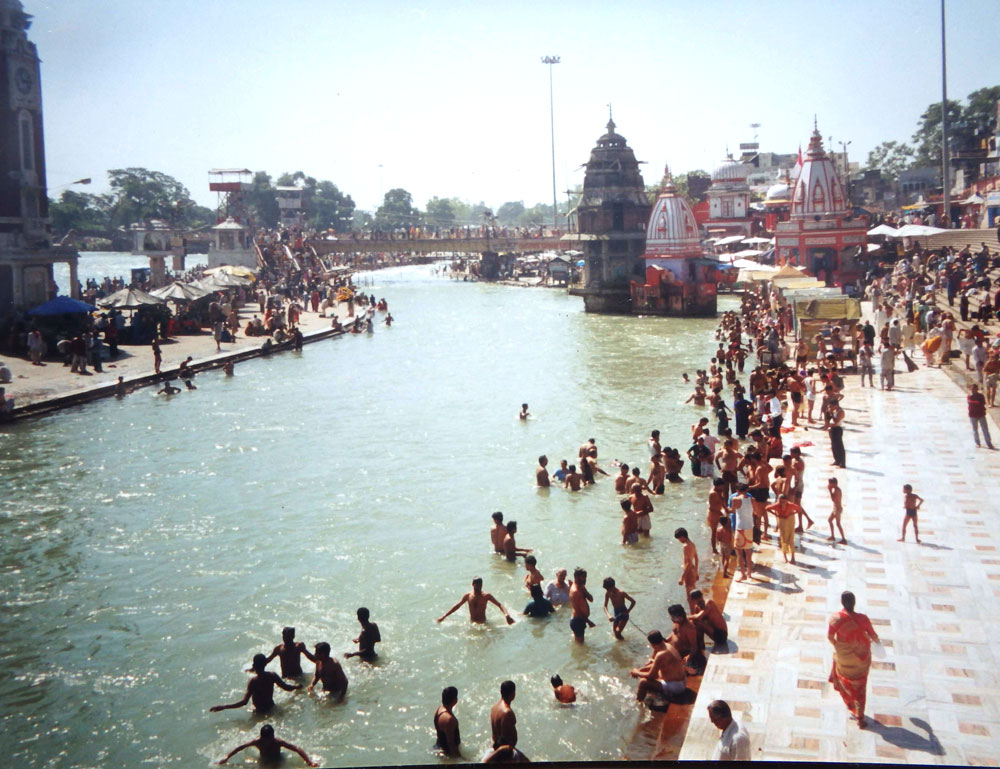
They come here from all over India to wait for death, in the most auspicious place for dying. This is the holy city of Varanasi, in northern India. Here, the eyes can witness the crimson sun rising from the Ganges’s waters at the break of day. Here stands Manikarnika, the burning ghat, a stone crematorium built on a massive bank over the River, right at the point where she finishes her bend to the north and once again turns to the east.
Here, men burn away the dead, and burn away history.
I stand at the third-floor window of a hospice building in the city’s center, watching Manikarnika. It is the hour of dusk. The heat of the day departs, leaving thin mist and burning stones behind. The sweet fragrance of sandalwood ascends from four funeral fires below. Boats loaded with firewood are roped to the bank. Boys shout and spring from them, swimming and playing catch in water murky from the ash.
Hindu men, most of them dressed in the mourning color of white, surround the fires. Women are not permitted at the cremation site, for their cries would taint the soul’s journey. In Varanasi, death is the ticket to liberation, an ending to the painful cycle of rebirths.
The corpse in the pyre on the far left has been completely consumed by flames. A man with a shaven head, the deceased’s eldest son, turns his back to the fire and lifts an earthen pot filled with water from the Ganges. He throws it over his right shoulder. The flames hiss. The vessel shatters. Men collect the smoldering ashes, and cast them into the river.
In the brownish water millions of lives merge into one. And from this Mother, lives are born again. How many generations have been carried away like this?
From a narrow lane stretching to the ghat I hear a chant. The words accompany the procession of a colorful bier as it makes its way to the fires.
“Raama naam satya hai, Raama naam satya hai.” God’s name is truth.
I had come to Varanasi from the former Muslim capital of Delhi, a city dotted with tombs, both splendid and ruined, that stand and fall as the legacy of the Mogul rulers. The beauty and size of the tombs testify to the greatness of the rulers interred within, and their determination to mark their lives for posterity.
After arriving in Varanasi, I met up with my Hindi teacher, Abhiji. We talked about Indian history, and soon started discussing an essay I had just read. The article, which was written by an English scholar, said that the Aryans came to India from Central Asia and laid the foundation to what became the upper tiers of the caste system. The former inhabitants—both indigenous and recently arrived—evolved into the untouchables.
When I mentioned the article’s thesis to him, Abhiji erupted. Foreign historians were propagating lies in order justify invaders of their own kind, he insisted. “The Britishers could never accept that the Aryans, including the English, originally came from India.”
I had little reason to doubt the English scholar’s account, but Abhiji’s outburst troubled me. It reminded me of the agenda-loaded history books I had skimmed despairingly in a Delhi bookstore a few days earlier. History for Indians, even educated ones like Abhiji, appeared to mean advancing their own political objectives. Perhaps it was a legacy of the colonial era, when rejecting the doctrines of their British rulers was a matter of liberty or oppression. In any case, it seemed that I could rarely find a book or enter a debate in which a genuine attempt was made to find the truth about past events.
Later that day, however, I realized that I had misunderstood the reasons behind Abhiji’s belief. In the shadow of Manikarnika, I watched ashes being poured from the pyres. I watched those human remnants as they dispersed on the water surface, slowly drifting downstream and then vanishing. In the emptiness left behind, I imagined the gorgeous tombs of the Mogul rulers in Delhi, and the simple gravesites clustered around village churches back in my homeland, the Czech Republic.
The ashes and the tombs. Compared with the fire-drenched stones of Manikarnika, the memorials of my Catholic and Czech culture and those of the Muslim culture of the Moguls are much alike. They both speak to the same need to remember, to preserve and magnify the memories of life. And yet here was a culture that had always dissolved the material remains of man—the stuff upon which any factual history is based.
The divide that separated me from Abhiji suddenly became clear to me. I remembered working as a tour guide in Prague, and taking Americans through Czech graveyards in search of their great-grandfathers. In the Western cultures, history is the words written on a stone, the lives carved into a tombstone. Abhiji, on the other hand, once explained to me how his caste is defined by a common ancestry from one rshi, or semi-divine sage. For Abhiji, there is no chronology to say when that sage existed, and when his great-grandfather lived, and so the two men merge in his perception; imagination creates history.
This difference between his view and mine appeared stark and irreconcilable. If the two of us differ so fundamentally in our conception of what constitutes our own past, how can we argue about history?
Abhiji has always struck me as a much-contented person, blessed with a happiness that comes from his strong faith in his gods and his ability to feel the divinity within himself. Perhaps the divine spirit pulses in his veins precisely because the tales of the past that he hears and tells are of gods. He grows into what his roots are. What is the point of forcing him to think “historically,” to separate myth and history, to argue about stones instead of relying on his own imagination?
In the past Abhiji imagines and lives by, the sacred Ganges is the womb from which all men once came and to which they return. The threat he hears in the English historian’s article is not so much the argument itself, but the habit of looking for concrete evidence to support an objective explanation. By defining Abhiji’s past for him, the historian also shapes what Abhiji believes himself to be.
In Abhiji’s perspective, history is part of one’s own belief and each individual has the right to create or choose his or her own. Thus, each individual also accepts that another person may choose a completely different version of the same story. The true origin of the Aryans is irrelevant. What is really at stake is how much claim the objective historian has over an area that is inherently private.
The dusk had deepened in Varanasi. The smoke-curtained sunset dazzled me. By and by I forgot both Abhiji and the Aryans, and another thought occurred to me: never before had I appreciated how much history defines who I am. I had seen the past as something that could be dug up and analyzed by others for me. I had seen the past as a stone. But perhaps if I considered the past to be a stone, I would become one, too. By surrendering to objective “truth,” I might forfeit the freedom to create and recreate myself.
Inside, I rebelled against the heaviness of that truth. There was an art to this act of living, I thought, and my life was too precious to be dictated by fossils.
Perhaps it was this thought, or just the evening sun, but the Ganges suddenly seemed to be more than the river I observed. She was vast and ageless and powerful. In her waters millions of lives merged into one.
I walked down along the river to a stone square where boys played cricket. Not ever doubting the superiority of soccer among games, I had never stopped before to watch a cricket match. That evening, however, I enthusiastically joined the youngsters in chasing wickets.
Jan Vihan Jan Vihan is a contributing writer for In The Fray.
- Follow us on Twitter: @inthefray
- Comment on stories or like us on Facebook
- Subscribe to our free email newsletter
- Send us your writing, photography, or artwork
- Republish our Creative Commons-licensed content

